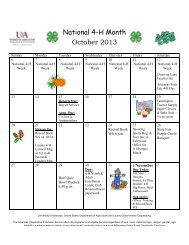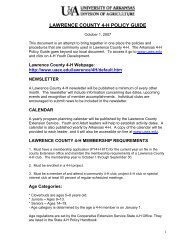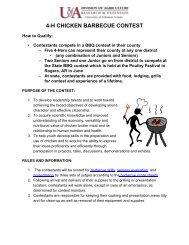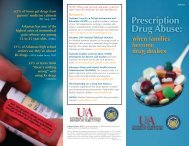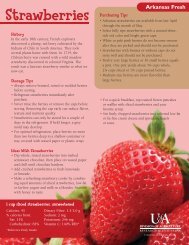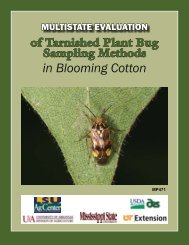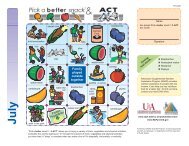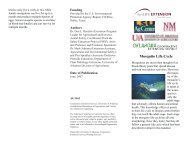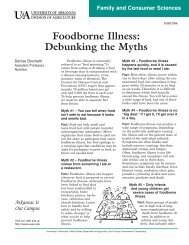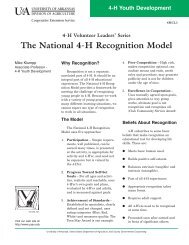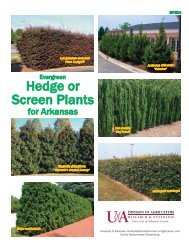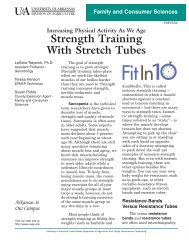Establishing Seeded Bermudagrass on Lawns, Golf Courses or ...
Establishing Seeded Bermudagrass on Lawns, Golf Courses or ...
Establishing Seeded Bermudagrass on Lawns, Golf Courses or ...
You also want an ePaper? Increase the reach of your titles
YUMPU automatically turns print PDFs into web optimized ePapers that Google loves.
Injury <strong>or</strong> phytotoxicity to bermudagrass varies<br />
am<strong>on</strong>g herbicides and varies depending up<strong>on</strong> timing<br />
of applicati<strong>on</strong> after emergence. However, under<br />
dense weed populati<strong>on</strong>s, the risk of herbicide injury<br />
from early applicati<strong>on</strong>s may be justified by<br />
decreased weed competiti<strong>on</strong>, allowing increased<br />
bermudagrass coverage.<br />
Crabgrass c<strong>on</strong>trol. Drive and MSMA are safe to<br />
use f<strong>or</strong> postemergence c<strong>on</strong>trol of annual grassy weeds<br />
<strong>on</strong> bermudagrass seedlings as early as <strong>on</strong>e week after<br />
emergence (WAE) (9,18,21). Some min<strong>or</strong> herbicide<br />
injury can be expected with MSMA and Drive, but<br />
effects are sh<strong>or</strong>t-lived, and herbicide injury from early<br />
applicati<strong>on</strong>s can be justified by decreased weed competiti<strong>on</strong><br />
(21). Avoid using Drive <strong>on</strong> Yuk<strong>on</strong> seedlings<br />
since they are especially pr<strong>on</strong>e to herbicide injury<br />
(10). Tank mixes of MSMA with other herbicides can<br />
also be used, but some tank mixes with MSMA cause<br />
m<strong>or</strong>e phyto toxicity than MSMA applied al<strong>on</strong>e (21).<br />
Pre emergence crabgrass c<strong>on</strong>trol can be achieved with<br />
applicati<strong>on</strong>s of Dimensi<strong>on</strong> (dithiopyr), Barricade<br />
(prodiamine) <strong>or</strong> Pre-M (pendimethalin) as early as<br />
3 WAE <strong>on</strong> bermudagrass seedlings (1).<br />
Goosegrass c<strong>on</strong>trol. Goosegrass is a difficult weed<br />
to c<strong>on</strong>trol in seedling turf and often requires sequential<br />
applicati<strong>on</strong>s with postemergence herbicides f<strong>or</strong><br />
c<strong>on</strong>trol. Goosegrass c<strong>on</strong>trol is best accomplished<br />
with postemergence herbicide applicati<strong>on</strong>s pri<strong>or</strong> to<br />
goosegrass tillering. Revolver (f<strong>or</strong>amsulfur<strong>on</strong>) and<br />
MSMA are safe to use 1 WAE <strong>on</strong> bermudagrass<br />
seedlings (9). Preemergence c<strong>on</strong>trol can be obtained<br />
with Dimensi<strong>on</strong>, Barricade <strong>or</strong> Pre-M applied as early<br />
as 3 WAE <strong>on</strong> bermudagrass seedlings (1). R<strong>on</strong>star<br />
(oxadiaz<strong>on</strong>) is a highly effective preemergence herbicide<br />
f<strong>or</strong> goosegrass, but it is yet to be evaluated f<strong>or</strong><br />
safety <strong>on</strong> bermudagrass seedlings. Illoxan (diclofop)<br />
w<strong>or</strong>ks well f<strong>or</strong> postemergence goosegrass c<strong>on</strong>trol in<br />
established bermudagrass but is phytotoxic to<br />
bermudagrass seedlings (9).<br />
Other grassy weed c<strong>on</strong>trol. It is often necessary<br />
to remove grassy weeds such as annual bluegrass<br />
(Poa annua) <strong>or</strong> perennial ryegrass (Lolium perenne)<br />
from seedling bermudagrass areas if they are not<br />
completely c<strong>on</strong>trolled pri<strong>or</strong> to seeding <strong>or</strong> if they germinate<br />
during grow-in. Revolver and TranXit (rimsulfur<strong>on</strong>)<br />
c<strong>on</strong>trol annual bluegrass and perennial<br />
ryegrass and are safe to apply pri<strong>or</strong> to seeding <strong>or</strong> as<br />
early as 1 WAE (1,10). Man<strong>or</strong>/Blade (metsulfur<strong>on</strong>)<br />
and M<strong>on</strong>ument (trifloxysulfur<strong>on</strong>) can also be used<br />
but should be delayed until 3 <strong>or</strong> 4 WAE to reduce<br />
injury (9,29,30).<br />
Broadleaf c<strong>on</strong>trol. Quicksilver and Drive are both<br />
labeled f<strong>or</strong> broadleaf c<strong>on</strong>trol in bermudagrass seed <br />
ling turf and can be applied as early as 1 WAE<br />
(2,9,29,30). L<strong>on</strong>trel (clopyralid) and Banvel (dicamba)<br />
are also safe <strong>on</strong> bermudagrass seedlings 1 WAE (9).<br />
Other three-way mixtures of herbicides such as<br />
Trimec (2,4-D + dicamba + mecoprop (MCPP)) can<br />
be used <strong>on</strong> bermudagrass seedlings at the <strong>on</strong>set of<br />
stol<strong>on</strong> development (10). C<strong>on</strong>fr<strong>on</strong>t (clopyralid + triclopyr)<br />
causes m<strong>or</strong>e toxicity than other broad leaf<br />
herbicides (21,38), and other products should be used<br />
<strong>or</strong> applicati<strong>on</strong>s made after 2 WAE.<br />
Sedge c<strong>on</strong>trol. Of the products labeled f<strong>or</strong> sedge<br />
<strong>or</strong> kyllinga c<strong>on</strong>trol in established bermudagrass,<br />
MSMA and Certainty (sulfo sulfur<strong>on</strong>) are the safest<br />
and can be applied bef<strong>or</strong>e seeding <strong>or</strong> as early as<br />
1 WAE (1,9). SedgeHammer (halosulfur<strong>on</strong>), Dismiss<br />
(sulfentraz<strong>on</strong>e) and M<strong>on</strong>ument can be applied<br />
3 WAE <strong>or</strong> later (1). M<strong>on</strong>ument + MSMA can also be<br />
used <strong>on</strong> bermudagrass seedlings 2 WAE <strong>or</strong> later<br />
with some sh<strong>or</strong>t-lived phytotoxicity (21). Image<br />
(imazaquin) should not be used <strong>on</strong> bermudagrass<br />
seedlings (1).<br />
Post-Seeding Fertilizati<strong>on</strong><br />
Nitrogen (N) fertilizati<strong>on</strong> is often applied to<br />
increase seedling establishment, but increasing<br />
m<strong>on</strong>thly N fertilizati<strong>on</strong> from 1.0 to 2.0 lb/1,000 ft 2<br />
using urea does not speed the establishment of seeded<br />
bermudagrass (18). Researchers in Kentucky found<br />
that applying lower N rates (4 lb/1,000 ft 2 /yr) using<br />
urea during establishment resulted in larger stol<strong>on</strong>s<br />
and greater carbohydrate reserves than did higher<br />
N rates (12 lb/1,000 ft 2 /yr), although they did not<br />
observe higher N rates leading to increased winter<br />
injury (15). Additi<strong>on</strong>al research found that late-seas<strong>on</strong><br />
N applicati<strong>on</strong>s pri<strong>or</strong> to frost promote fall col<strong>or</strong> retenti<strong>on</strong><br />
and do not have a negative effect <strong>on</strong> bermudagrass<br />
winter hardiness (13). Theref<strong>or</strong>e, our current<br />
recommendati<strong>on</strong>s are to apply 1.0 lb N/1,000 ft 2 at<br />
emergence and again m<strong>on</strong>thly throughout the growing<br />
seas<strong>on</strong> with the last applicati<strong>on</strong> being applied<br />
in September.<br />
Traffic Tolerance<br />
Compacti<strong>on</strong> is known to reduce the vegetative<br />
growth and root development of established<br />
bermudagrass (26). Seedlings are likely even m<strong>or</strong>e<br />
susceptible to damage. Theref<strong>or</strong>e, limiting <strong>or</strong> diverting<br />
golf cart and equipment traffic after seeding is<br />
10




